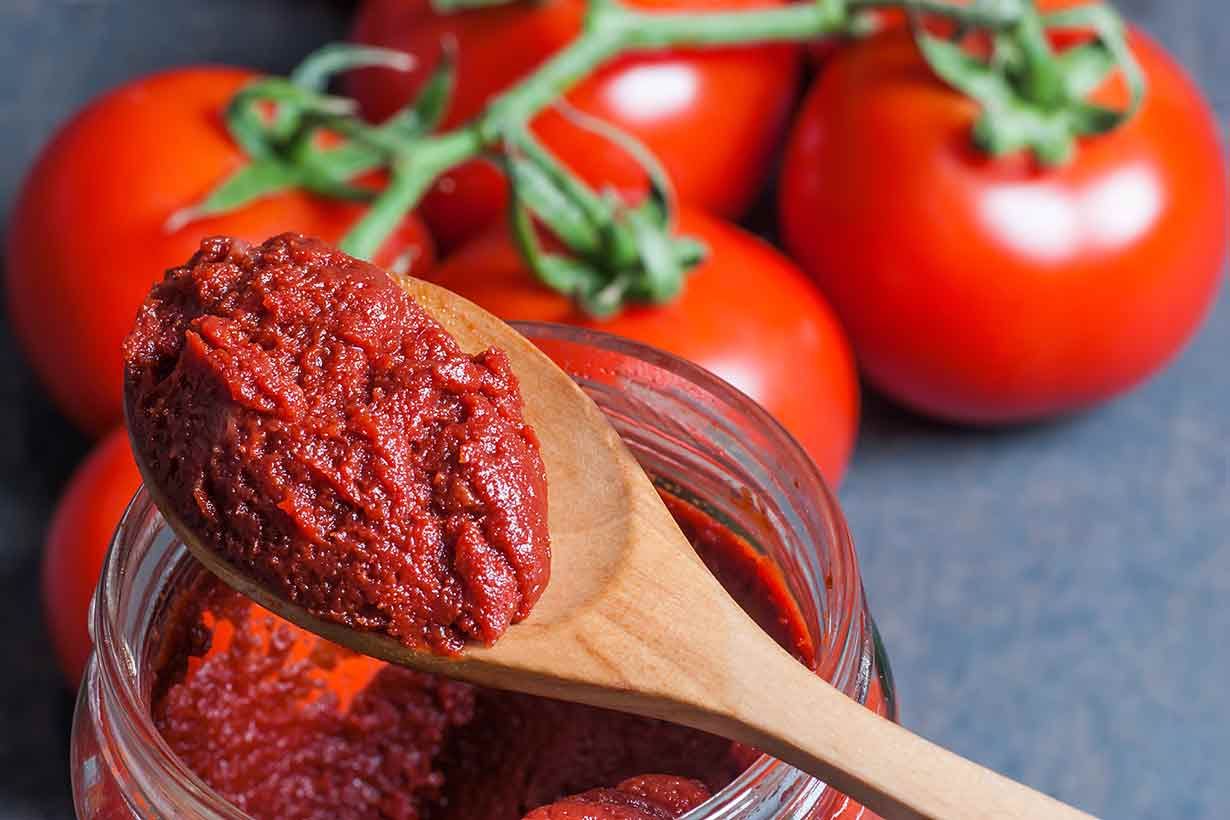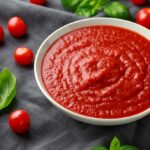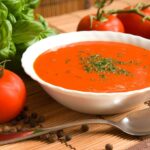Tomato paste is a flavorful ingredient made from tomatoes.
This thick and tasty paste plays a role in numerous recipes worldwide, from pizza to different varieties of tomato-based dishes.
This article looks at some benefits of using tomato paste, its nutritional values, and how to use it.
How Is Tomato Paste Made?

Before we look into the nutritional benefits of tomato paste, let’s first examine how to make it.
Firstly, producing tomato paste is fairly straightforward and involves no additional ingredients. However, producers can use two different processes to make it, known as ‘hot break’ and ‘cold break’ processing.
You can read about the production processes in more detail here, but here is a simplified summary (1, 2):
- Firstly, the tomatoes are sorted and then chopped until they develop into a pulp.
- Next, producers heat the tomatoes at a temperature of 65-75°C/149-167°F (cold break) or 85-95°C/185-203°F (hot break).
- Following this, the tomatoes’ seeds and skins are strained out of the mixture, leaving a liquid sauce-like consistency with no lumps.
- After this, the resulting tomato sauce is heated for several hours during various evaporation stages. The sauce develops a thicker consistency during this production stage as the tomatoes’ water content evaporates.
- Once the tomato paste has reached the desired consistency, it may undergo a pasteurization process at approximately 90°C.
- Finally, the tomato paste is then packaged and distributed for sale.
Benefits of Tomato Paste
Using tomato paste may offer several nutritional benefits; here is a look at some of its main advantages.
Tomato Paste Is a Significant Source of Lycopene
Tomatoes are the best dietary source of a carotenoid called lycopene.
Lycopene does not convert to vitamin A in the same way as other carotenoids. However, it does appear to benefit the human body. Additionally, lycopene’s bioavailability tends to be much higher in processed and heat-treated tomato products than in whole fresh tomatoes (3).
This compound is responsible for the bright red appearance of vegetables such as red bell peppers, red carrots, and other tomato products like passata (4).
Research on Lycopene and Tomato Paste
Here are some research findings from studies involving human participants:
- In a randomized trial featuring nineteen participants, 33 mg of lycopene per day from tomato paste improved endothelial function. Such improvements may be protective for cardiovascular health (6).
- A randomized controlled trial demonstrated that lycopene might potentially have protective properties against UV-induced damage. In this trial, twenty women consumed large amounts of lycopene via daily supplementation of 55 grams of tomato paste for 12 weeks. Compared to the control group, women’s skin in the tomato paste group had significantly reduced signs of UV-induced damage after 12 weeks. Lycopene’s UV-protective properties have also been demonstrated in human and animal studies (7, 8, 9).
- A systematic review and meta-analysis of tomato paste and lycopene supplementation noted that the existing literature supports a beneficial impact on cardiovascular risk factors such as endothelial function, blood lipids, and blood pressure (10).
It is also worth noting that research has demonstrated that consuming a food source of lycopene alongside dietary fat (such as olive oil) leads to greater absorption rates (11).
A 2-tablespoon (32-gram) serving of tomato paste provides approximately 29 mg of lycopene (12).
Low In Calories
Unlike many sauces and condiments, tomato paste is very low in calories. On this note, a 2-tablespoon (32-gram) serving comes to only 26 calories (12).
As well as being low in calories, this typical serving size is also low in carbohydrates (six grams) and low-fat (0.2 grams).
For these reasons, tomato paste can fit into a wide variety of popular diets, whether low-carb, low-fat, or vegan plant-based.
Offers a Broad Range of Vitamins and Minerals
Tomato paste does not contain a significant amount of any one vitamin or mineral, but it contains smaller amounts of numerous nutrients.
Among these nutrients, two tablespoons (32 grams) of tomato paste provides close to 10% of the daily value for copper, potassium, and vitamin C.
Tomato Paste Usually Contains No Additional Ingredients
While tomato paste tends to be reasonably healthy, jarred cooking sauces often contain additional ingredients.
For example, it is common for jarred cooking sauces to feature vegetable oils, added sugars, and large amounts of salt (and calories) per serving.
On the other hand, it’s easy enough to make more nutritious homemade sauces with tomato paste, a bit of salt, and some herbs and spices.
On the bonus side, it costs a lot less than canned and jarred ready-made sauces.
Nutrition Facts
Sourced from the USDA’s FoodData Central Database, here are the full nutritional values for tomato paste per typical serving size (two tablespoons) (12).
All daily values have been calculated from the USDA data and The FDA’s published daily values (12, 13).
| Name | Amount | % Daily Value |
|---|---|---|
| Calories | 26 kcal | 1.3% DV |
| Carbohydrate | 6.05 g | 2.2% DV |
| Fiber | 1.31 g | 4.7% DV |
| Sugars | 3.9 g | |
| Fat | 0.15 g | 0.2% DV |
| Saturated | 0.03 g | 0.2% DV |
| Monounsaturated | 0.02 g | |
| Polyunsaturated | 0.05 g | |
| Omega-3 | <0.01 g | |
| Omega-6 | 0.05 g | |
| Protein | 1.38 g | 2.8% DV |
Vitamins
- Vitamin E: 9% DV
- Vitamin C: 8% DV
- Niacin (B3): 6% DV
- Vitamin K: 3% DV
- Vitamin B6: 4% DV
- Riboflavin (B2): 4% DV
- Vitamin A: 3% DV
- Choline: 2% DV
- Thiamin (B1): 2% DV
- Folate: 1% DV
- Pantothenic acid (B5): 1% DV
Minerals
- Copper: 13% DV
- Potassium: 7% DV
- Iron: 5% DV
- Manganese: 4% DV
- Magnesium: 3% DV
- Phosphorus: 2% DV
- Selenium: 3% DV
- Zinc: 2% DV
- Calcium: 1% DV
- Sodium: 1% DV
As shown in the above nutritional values, tomato paste is a good source of copper, potassium, and vitamins C and E.
How To Use Tomato Paste
There are many different ways to use tomato paste in our cooking, but let’s stick to some of the simpler ways.
Pizza Base
Mix some tomato paste with some herbs such as rosemary, oregano, basil, and thyme. Add a little salt to taste, and then spread it on your pizza base.
Just add cheese and your preferred toppings to make a tasty homemade pizza.
To make it easier still, using dried Italian seasoning (disclosure: affiliate link) instead of individual herbs works well.
Curries and Tomato-Based Dishes
Tomato paste can work well in various tomato-based meals, from curries and spicy dishes to risottos and pasta dishes.
Soups and Stews
Mixing a tablespoon or two of tomato paste into a soup or stew is a simple way to enhance the flavor and increase the nutritional value.
On this note, a nutritional review of tomato soup is available here.
Make a Marinade
Tomato paste can be a key ingredient in a tasty marinade for meat, fish, poultry, and tofu-based recipes.
In this regard, the following simple recipe works very well:
- 1 tbsp tomato paste
- 1 tsp soy sauce
- 1/2 tsp sesame oil
- 1/2 tsp minced garlic
- Pinch of dried oregano (or herbs of choice)
Substitute For Fresh Tomato
Tomato paste can also be used as a substitute for any recipe with fresh tomatoes.
Here, a good rule of thumb is to use one tablespoon of tomato paste for every medium-sized tomato the recipe calls for.
Other Ideas
For more ideas on different ways to use tomato paste, a blend of 32 interesting recipes is available here.
What Type of Tomato Paste Is Best?
People often wonder which type of tomato paste is better.
The truth is that there are no differences between tomato paste in a tube, can, jar, or packet. These containers all provide the same food product inside, and the only real difference is the outer packaging.
There is really nothing wrong with any of these options, and it is better to go with personal preference or look for the best deal.
Does Tomato Paste Have Any Downsides?
Nutritionally, tomato paste is a relatively nutritious condiment with no major downsides.
However, as with all foods, some individuals can be allergic or intolerant to tomato products.
Although such allergies are rare, according to the University of Manchester’s allergenic food database, more than 50 allergic reactions to tomato-based products have been reported (14).
Anyone with a suspected allergy to tomatoes should consult their doctor.
Final Thoughts
Tomato paste offers a reasonable amount of nutrients for very few calories, is very affordable, and helps make food taste great.
This tasty condiment also has the unique benefit of being the best dietary source of lycopene.
All in all, using tomato paste is an easy way to upgrade a meal’s nutritional and taste characteristics.





I enjoy using tomato paste to spread on Ezekiel toast rather than butter and also as a spread instead of mayo when having a sandwich. A few grinds of pepper and a sprinkle of Himalayan salt and you’re in for a lovely savoury treat!